Beyond Human Interventions on Complex Bays: Effects on Water and Wave Dynamics (Study Case Cádiz Bay, Spain)
Abstract
:1. Introduction
2. Study Site
3. Methodology
3.1. Numerical Model
3.1.1. Model Description
3.1.2. Model Setup
3.1.3. Model Calibration and Testing
3.2. Modeled Scenarios and Locations of Interest
3.3. Variables Analyzed
3.3.1. Water and Salt Exchange in the Bay
3.3.2. Influence of Waves
4. Results and Discussion
4.1. Tidal Dynamics
4.2. Impact on Water Quality and Renewal Time
4.3. Changes in Salinity and Temperature
4.4. Potential Changes in Morphodynamics
4.5. Impacts on Wave Propagation and Impacts on Morphodynamics
5. Conclusions
- The inclusion of wave forcing and baroclinic processes in the numerical simulations allows to capture several effects on tidal dynamics that previous studies failed to analyze, such as the decrease in the amplitudes of the diurnal components as well as the amplification of the changes produced in the semi- and quarter-diurnal components. The deepening of the navigation channel will cause a decrease in the tidal wave, which will lead to a decrease in the overtidal components, reducing the effects due to friction. Also, there is a clear decrease in the celerity of the tidal wave (c), distancing its values from celerity in shallow waters (c). At the same time, the tidal wave tends to be more progressive in the inner bay, which is more similar to channels with a constant section and infinite length. This shows how the bay ceases acting as a convergent system to become a damping system, which can potentially soften the effects produced by the projected sea level rise.
- The greatest changes in salinity and temperature are observed close to the deepening area. R and R are directed towards the margins of the PC, which can change the sediment transport pattern. In addition, dredging intensifies the importance of the baroclinic terms, as the water column increases. The flushing time increases in PC due to the increase of water volume that requires more time for its displacement. These effects can also be observed in the exchange rates where, as the latter increases and as neither R nor R varies, R gains importance. A decrease of R is observed, possibly caused by the reduction of the difference in salinity between the outer bay and PC. Finally, it is shown how dredging dumps the seasonal variability of salinity and temperature, something to be considered in the future as climate change will cause an increase in water temperature for the study area.
- Regarding the morphodynamics, the deepening of the channel causes an increase in the bed shear stresses, exceeding the critical values of erosion, increasing the lifetime of the dredging but also increasing the sedimentation on its surroundings where the eroded sediment will possibly be deposited, thus decreasing the cross section of PC. Furthermore, such erosion will result in increased turbidity which will impact on the biogeochemistry of PC.
- The greatest changes in wave energy flux are observed in NC, especially near the new terminal where the decrease in wave height due to the channel deepening causes a decrease in the energy flow module, favoring the operation of the new terminal. The changes in the coastal morphology of the beaches of Valdelagrana and Rota will be very limited, although there is a reduction in the energy content that will alter the energy that moves the sediment, especially for certain wave conditions, which added to climate change, can modify the mid- to long-term morphodynamics of these beaches.
Supplementary Materials
Author Contributions
Funding
Acknowledgments
Conflicts of Interest
References
- Ferrarin, C.; Ghezzo, M.; Umgiesser, G.; Tagliapietra, D.; Camatti, E.; Zaggia, L.; Sarretta, A. Assessing hydrological effects of human interventions on coastal systems: Numerical applications to the Venice Lagoon. Hydrol. Earth Syst. Sci. 2013, 17, 1733–1748. [Google Scholar] [CrossRef] [Green Version]
- French, J.; Burningham, H.; Thornhill, G.; Whitehouse, R.; Nicholls, R.J. Conceptualising and mapping coupled estuary, coast and inner shelf sediment systems. Geomorphology 2016, 256, 17–35. [Google Scholar] [CrossRef] [Green Version]
- Cobos, M.; Baquerizo, A.; Díez-Minguito, M.; Losada Rodríguez, M. A Subtidal Box Model based on the Longitudinal Anomaly of Potential Energy for Narrow Estuaries. An Application to the Guadalquivir River Estuary (SW Spain). J. Geophys. Res. Ocean. 2020. [Google Scholar] [CrossRef]
- Del-Rosal-Salido, J.; Folgueras, P.; Ortega-Sánchez, M.; Losada, M.Á. Beyond flood probability assessment: An integrated approach for characterizing extreme water levels along transitional environments. Coast. Eng. 2019, 152, 103512. [Google Scholar] [CrossRef]
- Schuttelaars, H.M.; de Jonge, V.N.; Chernetsky, A. Improving the predictive power when modelling physical effects of human interventions in estuarine systems. Ocean. Coast. Manag. 2013, 79, 70–82. [Google Scholar] [CrossRef]
- Ruiz, J.; Polo, M.J.; Díez-Minguito, M.; Navarro, G.; Morris, E.P.; Huertas, E.; Caballero, I.; Contreras, E.; Losada, M.A. The Guadalquivir Estuary: A Hot Spot for Environmental and Human Conflicts. In Environmental Management and Governance: Advances in Coastal and Marine Resources; Finkl, C.W., Makowski, C., Eds.; Springer International Publishing: Cham, Switzerlands, 2015; pp. 199–232. [Google Scholar] [CrossRef]
- Elliott, M.; Burdon, D.; Hemingway, K.L.; Apitz, S.E. Estuarine, coastal and marine ecosystem restoration: Confusing management and science—A revision of concepts. Estuar. Coast. Shelf Sci. 2007, 74, 349–366. [Google Scholar] [CrossRef]
- Zhu, C.; Guo, L.; van Maren, D.S.; Tian, B.; Wang, X.; He, Q.; Wang, Z.B. Decadal morphological evolution of the mouth zone of the Yangtze Estuary in response to human interventions. Earth Surf. Process. Landf. 2019, 44, 2319–2332. [Google Scholar] [CrossRef]
- Cai, H.; Savenije, H.H.G.; Yang, Q.; Ou, S.; Lei, Y. Influence of River Discharge and Dredging on Tidal Wave Propagation: Modaomen Estuary Case. J. Hydraul. Eng. 2012, 138, 885–896. [Google Scholar] [CrossRef]
- Díez-Minguito, M.; Baquerizo, A.; Ortega-Sánchez, M.; Navarro, G.; Losada, M.A. Tide transformation in the Guadalquivir estuary (SW Spain) and process-based zonation. J. Geophys. Res. 2012, 117, 1–14. [Google Scholar] [CrossRef] [Green Version]
- Winterwerp, J.C.; Wang, Z.B. Man-induced regime shifts in small estuaries–I: Theory. Ocean. Dyn. 2013, 63, 1279–1292. [Google Scholar] [CrossRef]
- Zarzuelo, C.; Díez-Minguito, M.; Ortega-Sánchez, M.; López-Ruiz, A.; Losada, M.A. Hydrodynamics response to planned human interventions in a highly altered embayment: The example of the Bay of Cádiz (Spain). Estuar. Coast. Shelf Sci. 2015, 167, 1–11. [Google Scholar] [CrossRef]
- Liu, S.M.; Li, L.W.; Zhang, G.L.; Liu, Z.; Yu, Z.; Ren, J.L. Impacts of human activities on nutrient transports in the Huanghe (Yellow River) estuary. J. Hydrol. 2012, 430–431, 103–110. [Google Scholar] [CrossRef]
- Tönis, I.E.; Stam, J.M.; Van De Graaf, J. Morphological changes of the Haringvliet estuary after closure in 1970. Coast. Eng. 2002, 44, 191–203. [Google Scholar] [CrossRef]
- Wang, Z.B.; Van Maren, D.S.; Ding, P.X.; Yang, S.L.; Van Prooijen, B.C.; De Vet, P.L.; Winterwerp, J.C.; De Vriend, H.J.; Stive, M.J.; He, Q. Human impacts on morphodynamic thresholds in estuarine systems. Cont. Shelf Res. 2015, 111, 174–183. [Google Scholar] [CrossRef]
- Zarzuelo, C.; López-Ruiz, A.; Ortega-Sánchez, M. Evaluating the impact of dredging strategies at tidal inlets: Performance assessment. Sci. Total Environ. 2019, 658, 1069–1084. [Google Scholar] [CrossRef]
- Garel, E. Efficient dredging strategy for channel maintenance of the Guadiana ebb-delta. Proc. Coast. Dyn. 2017, 2017, 1–10. [Google Scholar]
- Garel, E.; López-Ruiz, A.; Ferreira, Ó. A method to estimate the longshore sediment transport at ebb-tidal deltas based on their volumetric growth: Application to the Guadiana (Spain-Portugal border). Earth Surf. Process. Landf. 2019, 44, 2557–2569. [Google Scholar] [CrossRef] [Green Version]
- Purkerson, D.G.; Doblin, M.A.; Bollens, S.M.; Luoma, S.N.; Cutter, G.A. Selenium in San Francisco Bay zooplankton: Potential effects of hydrodynamics and food web interactions. Estuaries 2003, 26, 956–969. [Google Scholar] [CrossRef]
- Elias, E.P.; Hansen, J.E. Understanding processes controlling sediment transports at the mouth of a highly energetic inlet system (San Francisco Bay, CA). Mar. Geol. 2013, 345, 207–220. [Google Scholar] [CrossRef]
- Shen, C.; Testa, J.M.; Ni, W.; Cai, W.J.; Li, M.; Kemp, W.M. Ecosystem metabolism and carbon balance in Chesapeake Bay: A 30-year analysis using a coupled hydrodynamic-biogeochemical model. J. Geophys. Res. Ocean. 2019, 124, 6141–6153. [Google Scholar] [CrossRef]
- Luan, H.L.; Ding, P.X.; Wang, Z.B.; Yang, S.L.; Lu, J.Y. Morphodynamic impacts of large-scale engineering projects in the Yangtze River delta. Coast. Eng. 2018, 141, 1–11. [Google Scholar] [CrossRef]
- Chen, Q.; Zhu, J.; Lyu, H.; Pan, S.; Chen, S. Impacts of topography change on saltwater intrusion over the past decade in the Changjiang Estuary. Estuar. Coast. Shelf Sci. 2019, 231, 106469. [Google Scholar] [CrossRef]
- Hearn, C.J.; Robson, B.J. On the effects of wind and tides on the hydrodynamics of a shallow Mediterranean estuary. Cont. Shelf Res. 2002, 22, 2655–2672. [Google Scholar] [CrossRef]
- Zarzuelo, C.; D’Alpaos, A.; Carniello, L.; López-Ruiz, A.; Díez-Minguito, M.; Ortega-Sánchez, M. Natural and Human-Induced Flow and Sediment Transport within Tidal Creek Networks Influenced by Ocean-Bay Tides. Water 2019, 11, 1493. [Google Scholar] [CrossRef] [Green Version]
- Zarzuelo, C.; López-Ruiz, A.; D’Alpaos, A.; Carniello, L.; Ortega-Sánchez, M. Assessing the morphodynamic response of human-altered tidal embayments. Geomorphology 2018, 320, 127–141. [Google Scholar] [CrossRef]
- Elliott, M.; Day, J.W.; Ramachandran, R.; Wolanski, E. A synthesis: What is the future for coasts, estuaries, deltas and other transitional habitats in 2050 and beyond? In Coasts and Estuaries; Elsevier: Amsterdam, The Netherlands, 2019; pp. 1–28. [Google Scholar]
- Zarzuelo, C.; López-Ruiz, A.; Ortega-Sánchez, M. The role of waves and heat exchange in the hydrodynamics of multi-basin bays. J. Geophys. Res. Ocean. 2020. under review. [Google Scholar]
- Lesser, G.; Roelvink, J.; Van Kester, J.; Stelling, G. Development and validation of a three-dimensional morphological model. Coast. Eng. 2004, 51, 883–915. [Google Scholar] [CrossRef]
- Holthuijsen, L.; Booij, N.; Ris, R. A spectral wave model for the coastal zone. In Ocean Wave Measurement and Analysis; ASCE: New Orleans, LA, USA, 1993; pp. 630–641. [Google Scholar]
- Cañizares, R.; Smith, E.; Alfageme, S. Estuarine and Coastal Modeling; ASCE: St. Petersburg, FL, USA, 2002; pp. 812–829. [Google Scholar]
- Thanh, V.Q.; Reyns, J.; Wackerman, C.; Eidam, E.F.; Roelvink, D. Modelling suspended sediment dynamics on the subaqueous delta of the Mekong River. Cont. Shelf Res. 2017, 147, 213–230. [Google Scholar] [CrossRef]
- Wan, Y.; Wang, L. Numerical investigation of the factors influencing the vertical profiles of current, salinity, and SSC within a turbidity maximum zone. Int. J. Sediment Res. 2017, 32, 20–33. [Google Scholar] [CrossRef]
- Egbert, G.; Erofeeca, S. Efficient inverse modeling of barotropic ocean tides. J. Atmos. Ocean. Tech. 2002, 19, 183–204. [Google Scholar] [CrossRef] [Green Version]
- Zarzuelo, C.; López-Ruiz, A.; Ortega-Sánchez, M. Data for the Hydrodynamic, Salinity and Temperature 2D Numerical Simulation at Cádiz Bay (Spain). 2020. Available online: https://zenodo.org/record/3764688#.XwLCyygzZPY (accessed on 1 May 2020).
- Zarzuelo, C.; López-Ruiz, A.; Díez-Minguito, M.; Ortega-Sánchez, M. Tidal and subtidal hydrodynamics and energetics in a constricted estuary. Estuar. Coast. Shelf Sci. 2017, 185, 55–68. [Google Scholar] [CrossRef]
- Soetaert, K.; Herman, P.M. Estimating estuarine residence times in the Westerschelde (The Netherlands) using a box model with fixed dispersion coefficients. Hydrobiologia 1995, 311, 215–224. [Google Scholar] [CrossRef]
- Steen, R.; Evers, E.; Van Hattum, B.; Cofino, W.; Brinkman, U.T. Net fluxes of pesticides from the Scheldt Estuary into the North Sea: A model approach. Environ. Pollut. 2002, 116, 75–84. [Google Scholar] [CrossRef]
- Hearn, C.; Sidhu, H. The Stommel model of shallow coastal lagoons. Proc. R. Soc. London. Ser. Math. Phys. Eng. Sci. 1999, 455, 3997–4011. [Google Scholar] [CrossRef]
- Hearn, C.; Lukatelich, R. Dynamics of Peel-Harvey Estuary, Southwest Australia. In Residual Currents and Long-term Transport; Springer: New York, NY, USA, 1990; pp. 431–450. [Google Scholar]
- Mudge, S.M.; Icely, J.D.; Newton, A. Residence times in a hypersaline lagoon: Using salinity as a tracer. Estuar. Coast. Shelf Sci. 2008, 77, 278–284. [Google Scholar] [CrossRef]
- Elshinnawy, A.I.; Medina, R.; González, M. On the influence of wave directional spreading on the equilibrium planform of embayed beaches. Coast. Eng. 2018, 133, 59–75. [Google Scholar] [CrossRef]
- Martyr-Koller, R.; Kernkamp, H.; van Dam, A.; van der Wegen, M.; Lucas, L.; Knowles, N.; Jaffe, B.; Fregoso, T. Application of an unstructured 3D finite volume numerical model to flows and salinity dynamics in the San Francisco Bay-Delta. Estuar. Coast. Shelf Sci. 2017, 192, 86–107. [Google Scholar] [CrossRef]
- Chen, X.; Sun, Z.; Lin, H.; Zhu, J.; Hu, J. Analysis of temperature inversion in the Zhujiang River Estuary in July 2015. Acta Oceanol. Sin. 2019, 38, 167–174. [Google Scholar] [CrossRef]
- Savenije, H.H. Salinity and Tides in Alluvial Estuaries; Elsevier Science: Amsterdam, The Netherlands, 2005. [Google Scholar] [CrossRef]
- Savenije, H.H.; Toffolon, M.; Haas, J.; Veling, E.J. Analytical description of tidal dynamics in convergent estuaries. J. Geophys. Res. Ocean. 2008, 113. [Google Scholar] [CrossRef]
- van Rijn, L.C. Analytical and numerical analysis of tides and salinities in estuaries; part I: Tidal wave propagation in convergent estuaries. Ocean. Dyn. 2011, 61, 1719–1741. [Google Scholar] [CrossRef]
- Hong, B.; Shen, J. Responses of estuarine salinity and transport processes to potential future sea-level rise in the Chesapeake Bay. Estuar. Coast. Shelf Sci. 2012, 104, 33–45. [Google Scholar] [CrossRef]
- Hsu, M.H.; Kuo, A.Y.; Kuo, J.T.; Liu, W.C. Procedure to calibrate and verify numerical models of estuarine hydrodynamics. J. Hydraul. Eng. 1999, 125, 166–182. [Google Scholar] [CrossRef]
- Liu, W.C.; Hsu, M.H.; Kuo, A.Y. Modelling of hydrodynamics and cohesive sediment transport in Tanshui River estuarine system, Taiwan. Mar. Pollut. Bull. 2002, 44, 1076–1088. [Google Scholar] [CrossRef]
- Hunt, S.; Bryan, K.R.; Mullarney, J.C. The influence of wind and waves on the existence of stable intertidal morphology in meso-tidal estuaries. Geomorphology 2015, 228, 158–174. [Google Scholar] [CrossRef]
- Qiu, C.; Zhu, J. Assessing the influence of sea level rise on salt transport processes and estuarine circulation in the Changjiang River estuary. J. Coast. Res. 2015, 31, 661–670. [Google Scholar] [CrossRef]
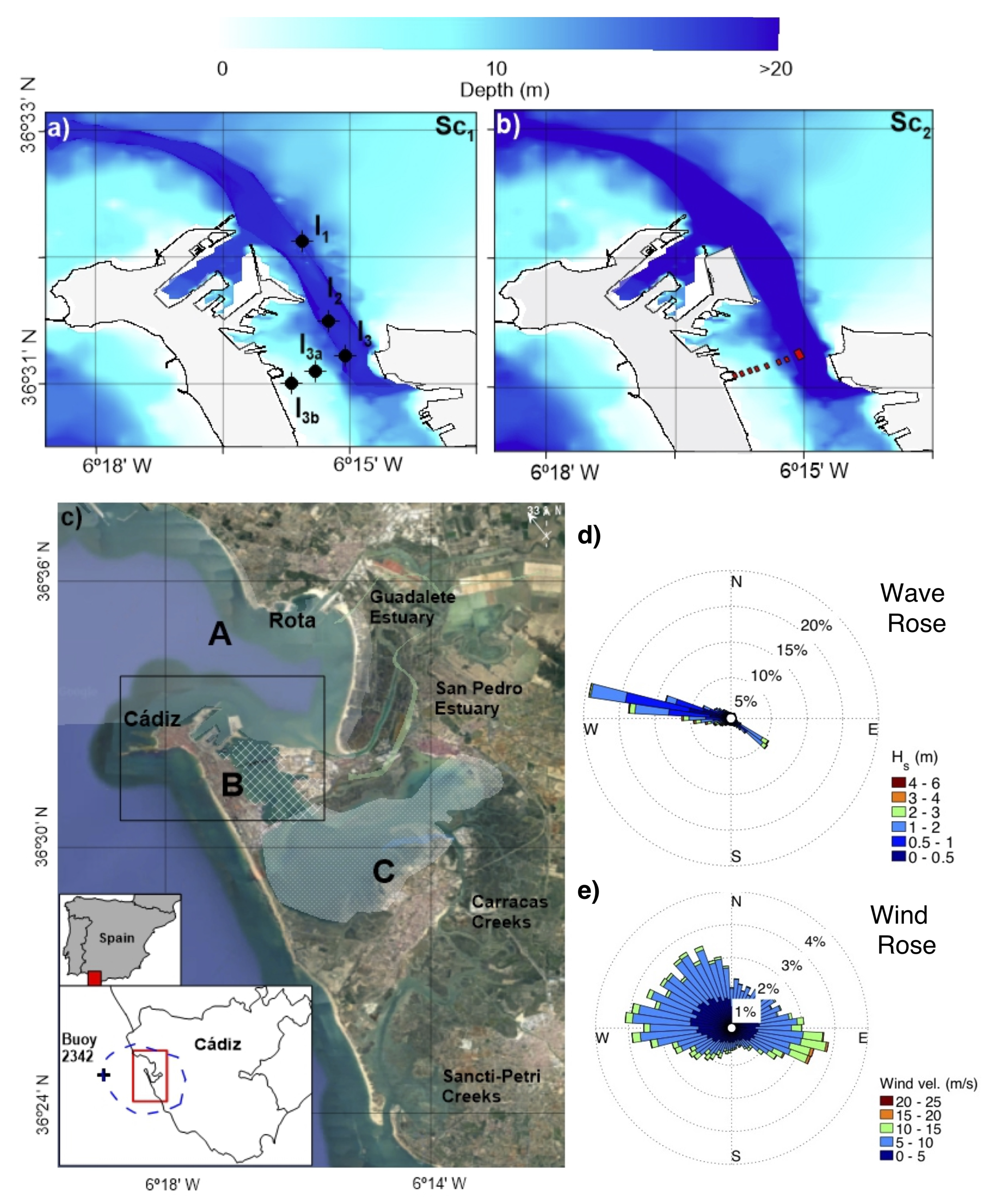
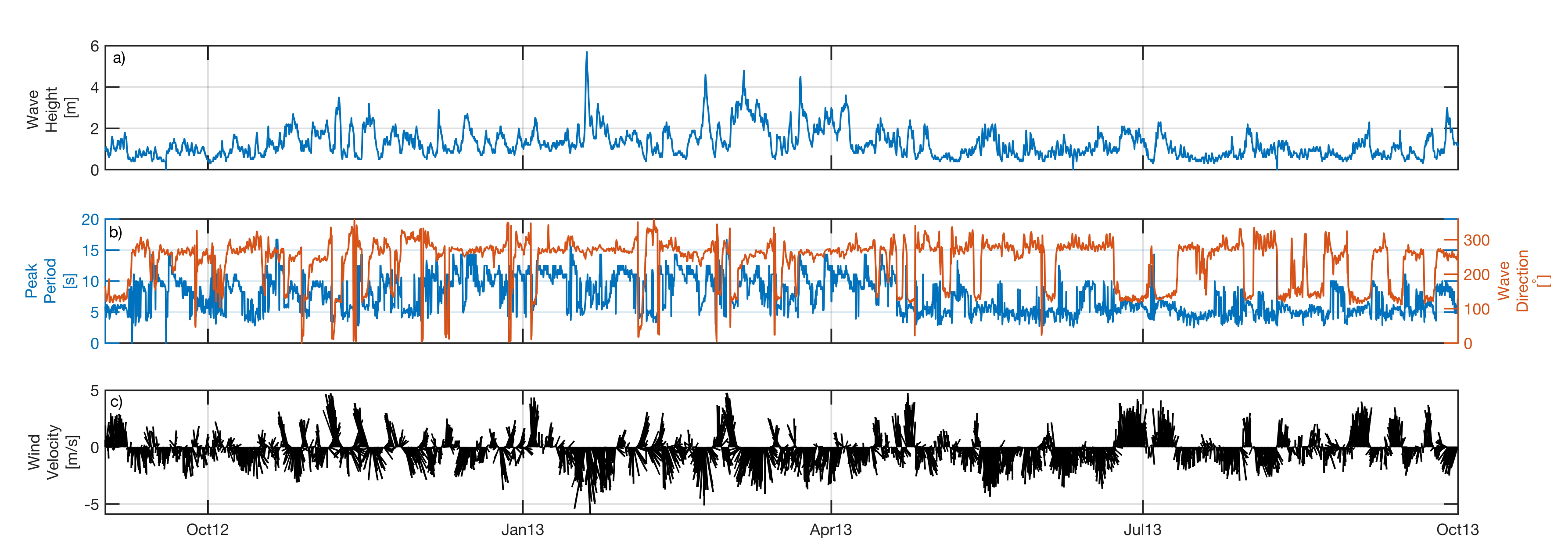
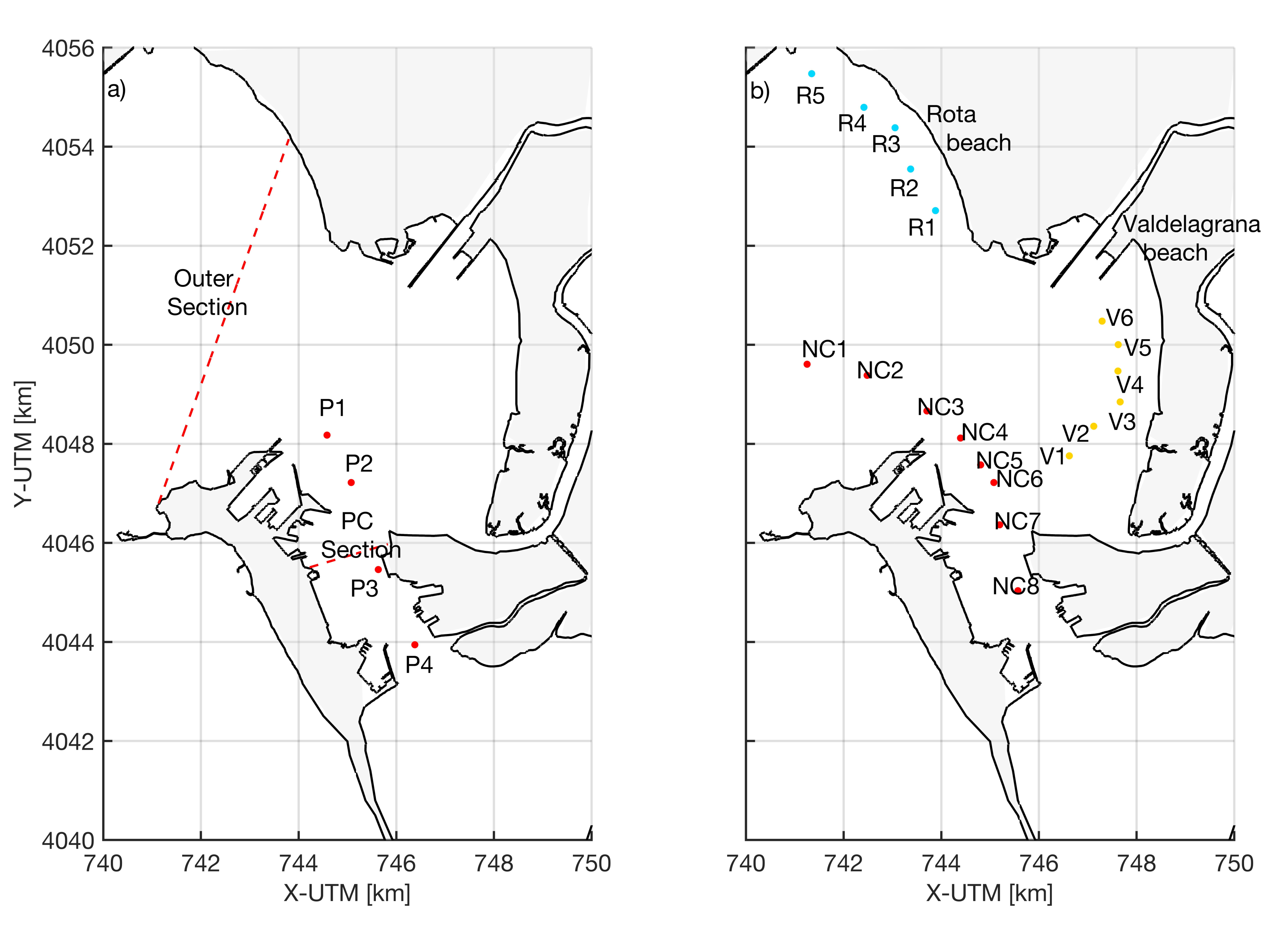
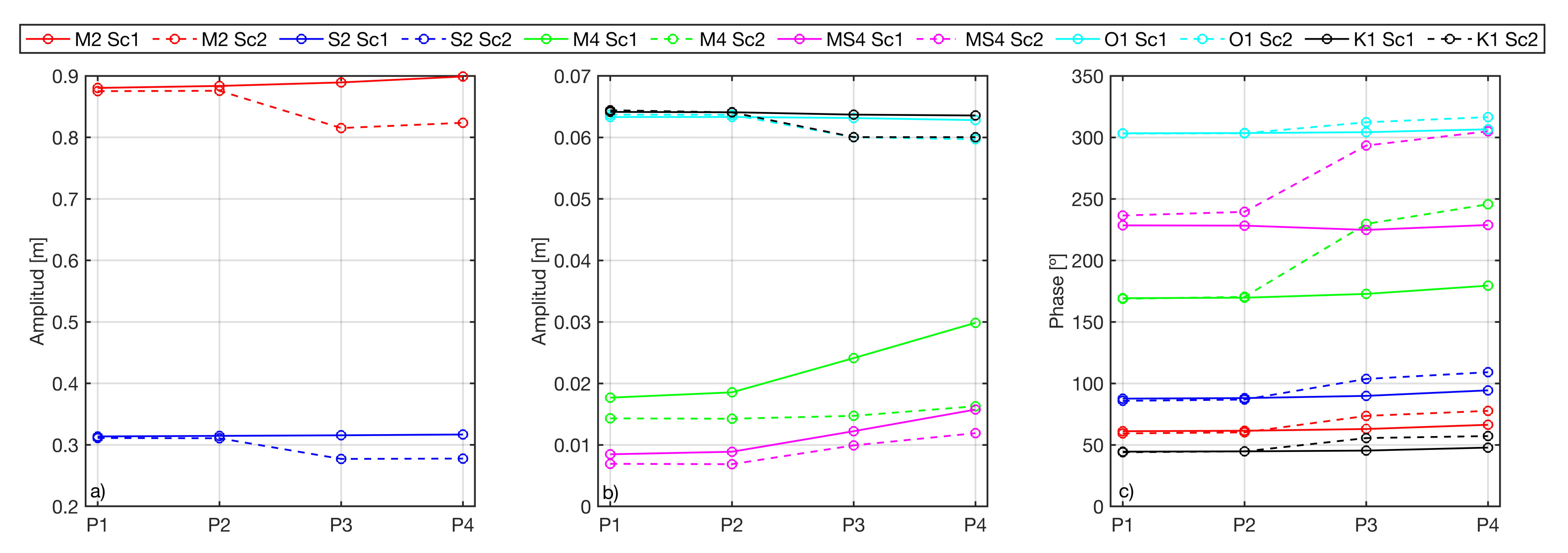
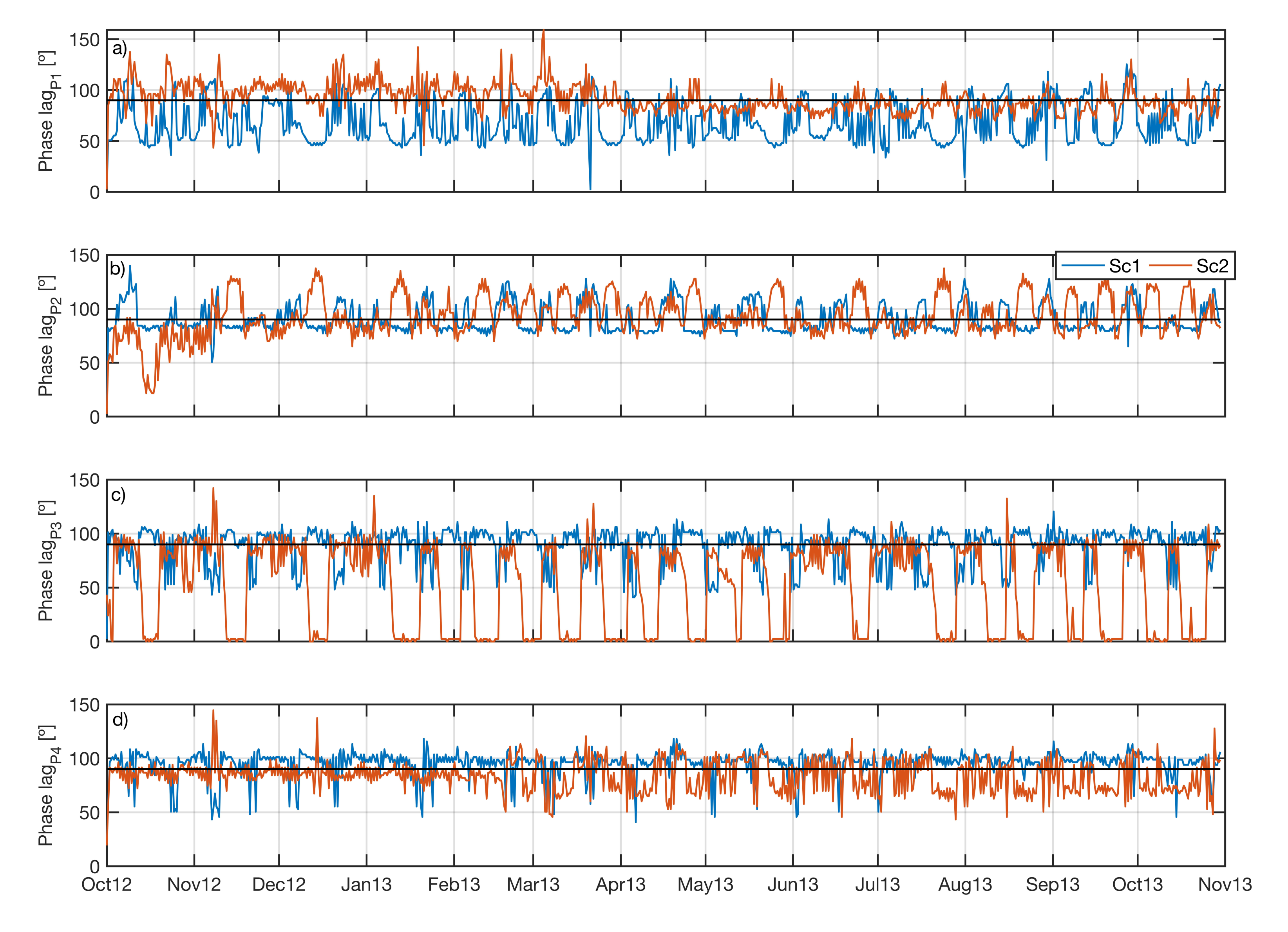
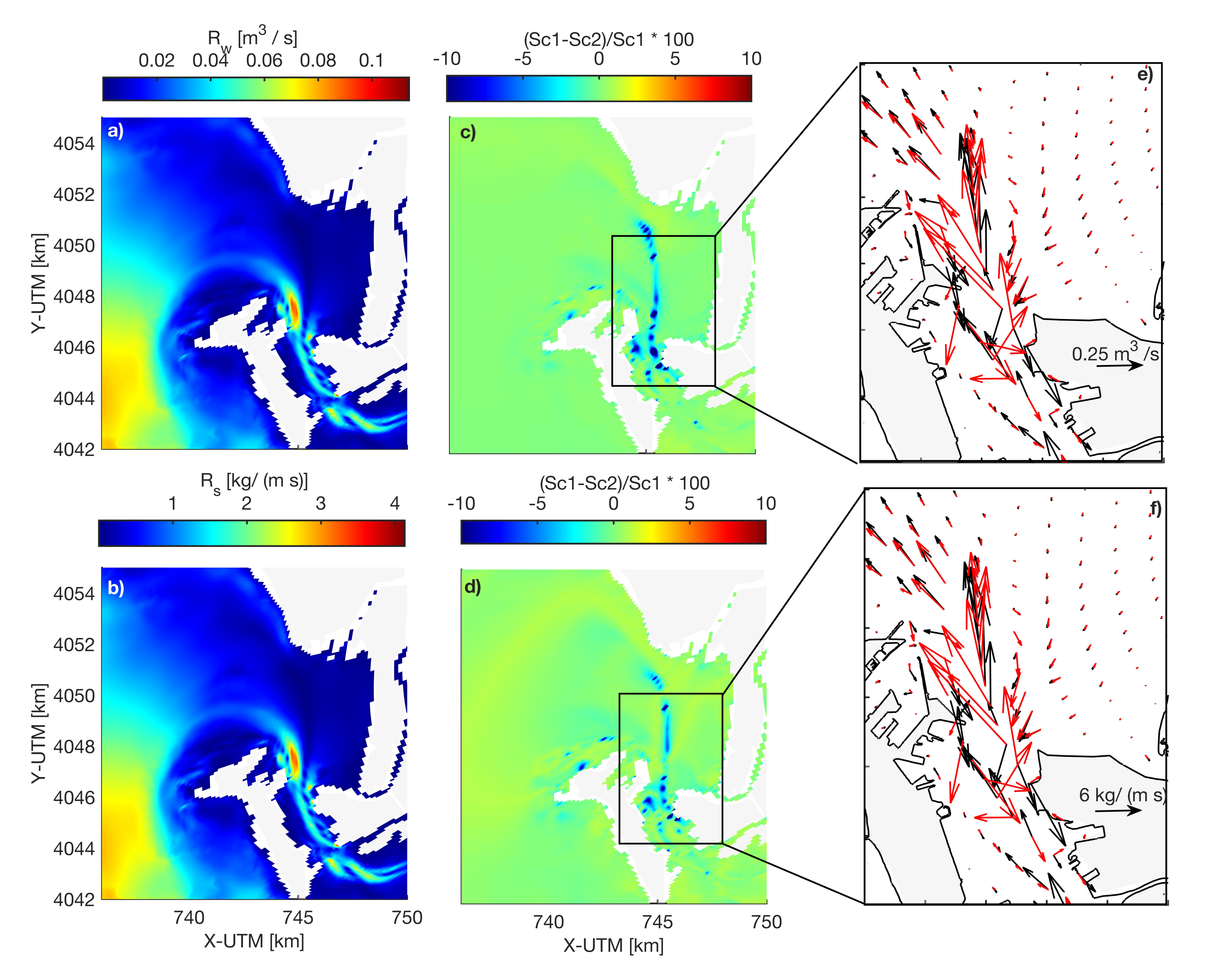
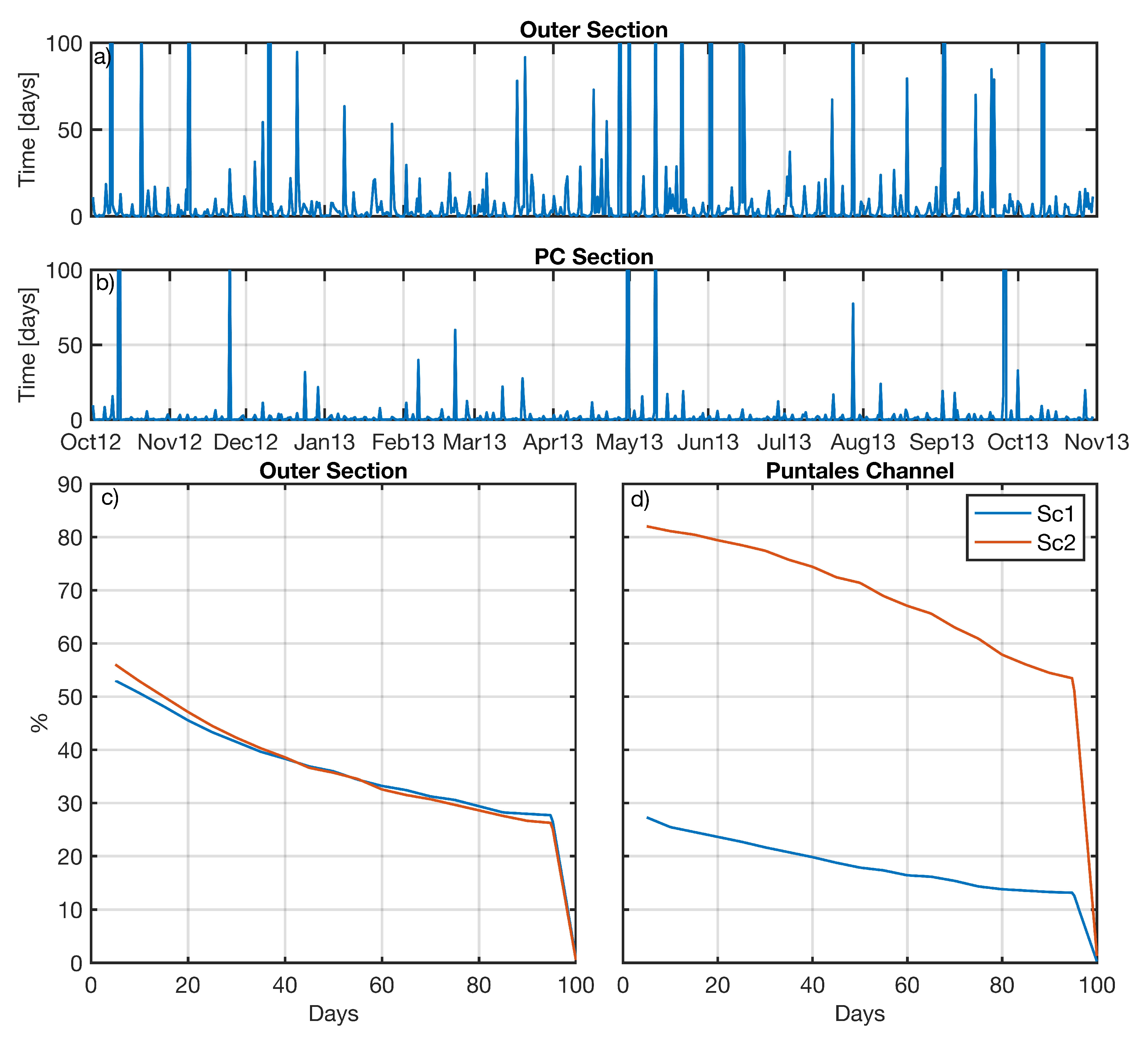
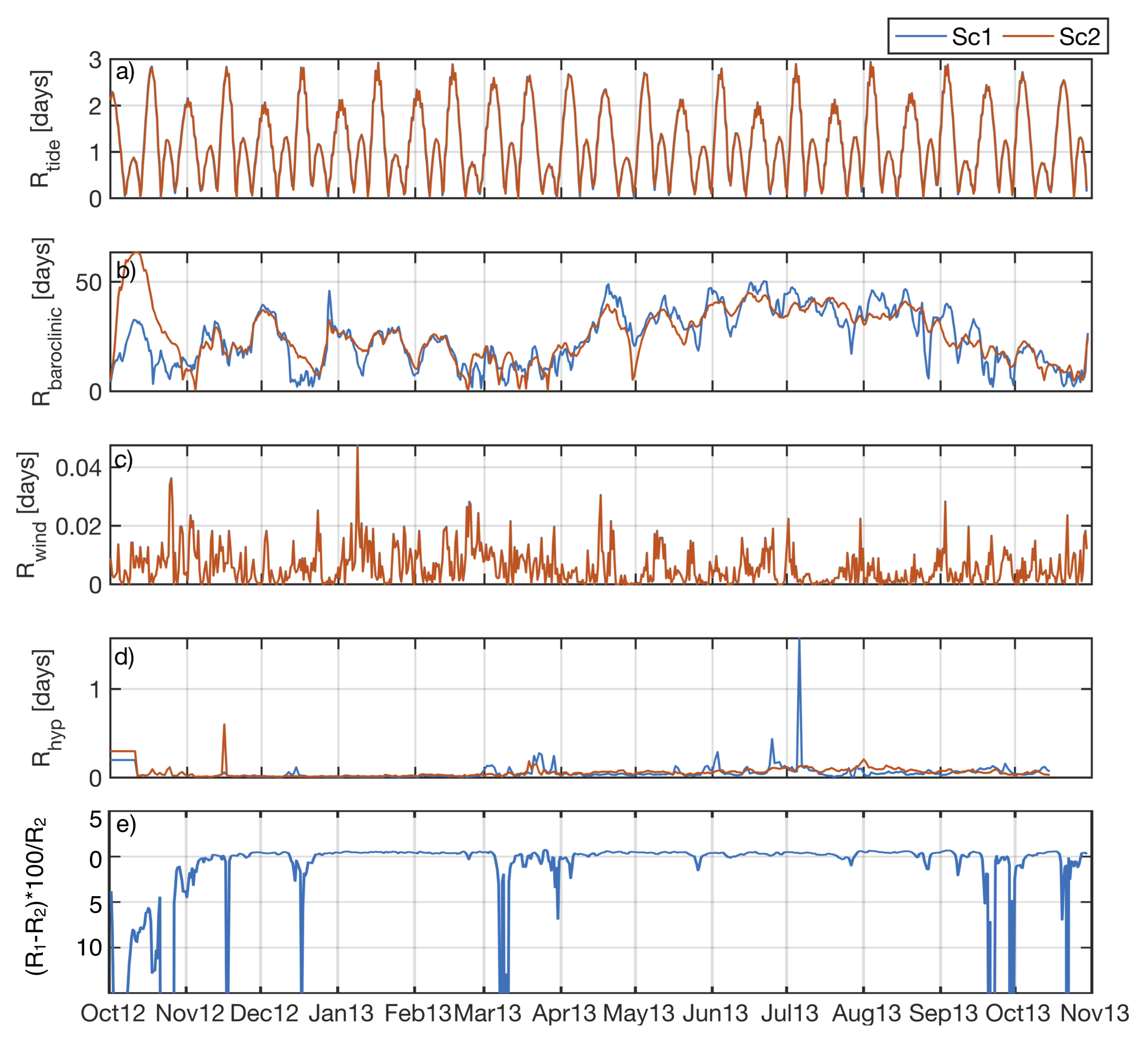
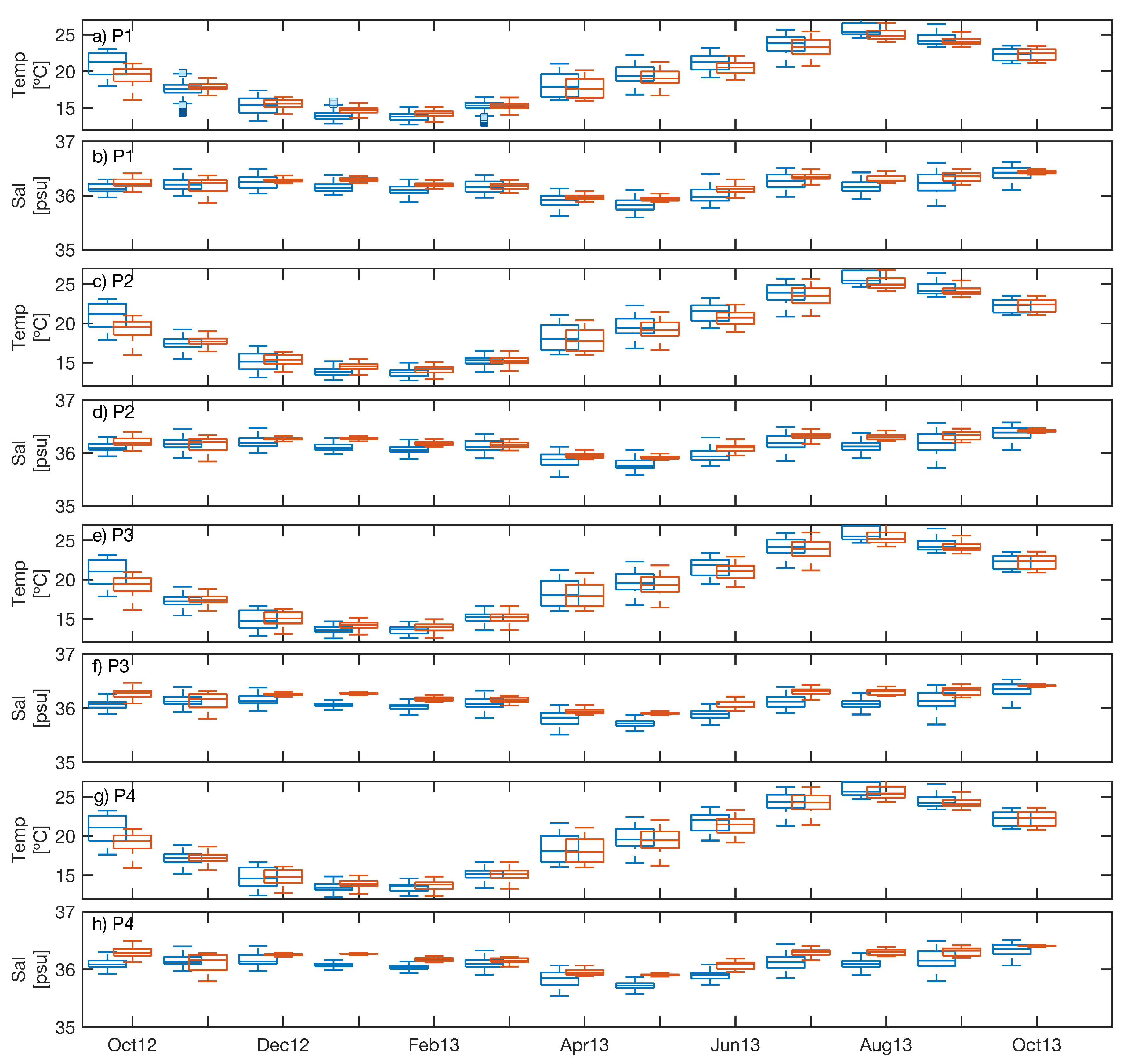
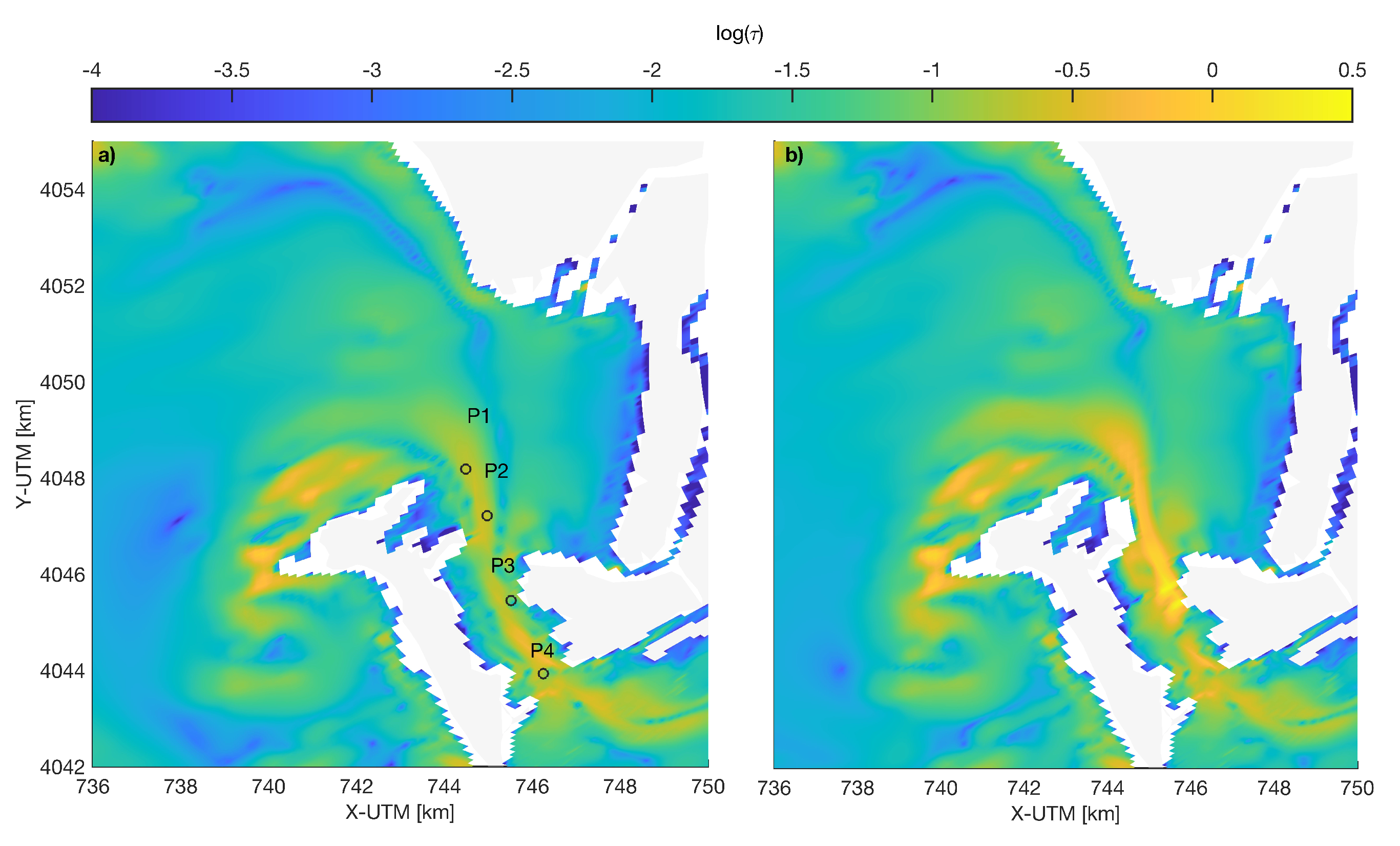
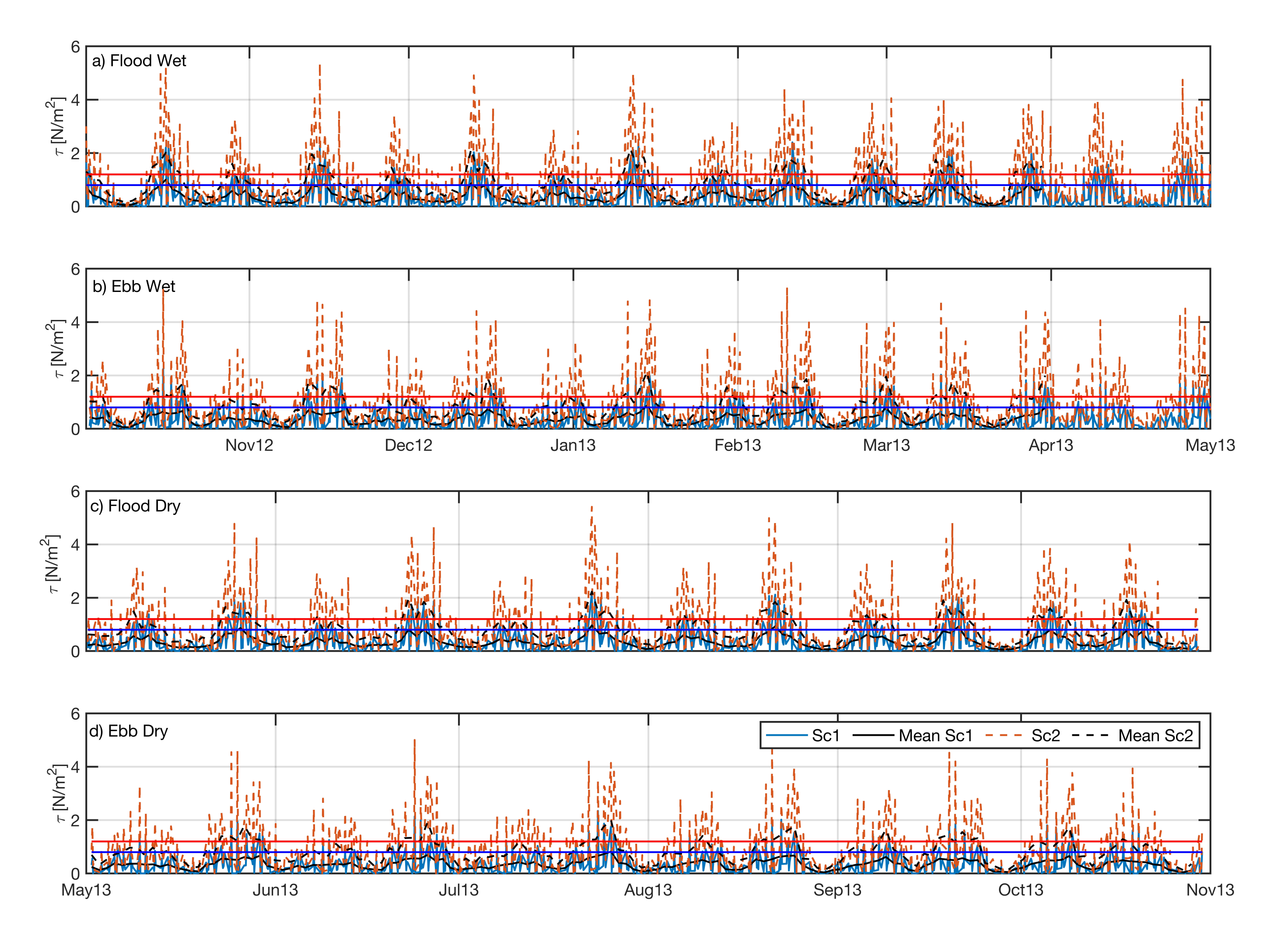
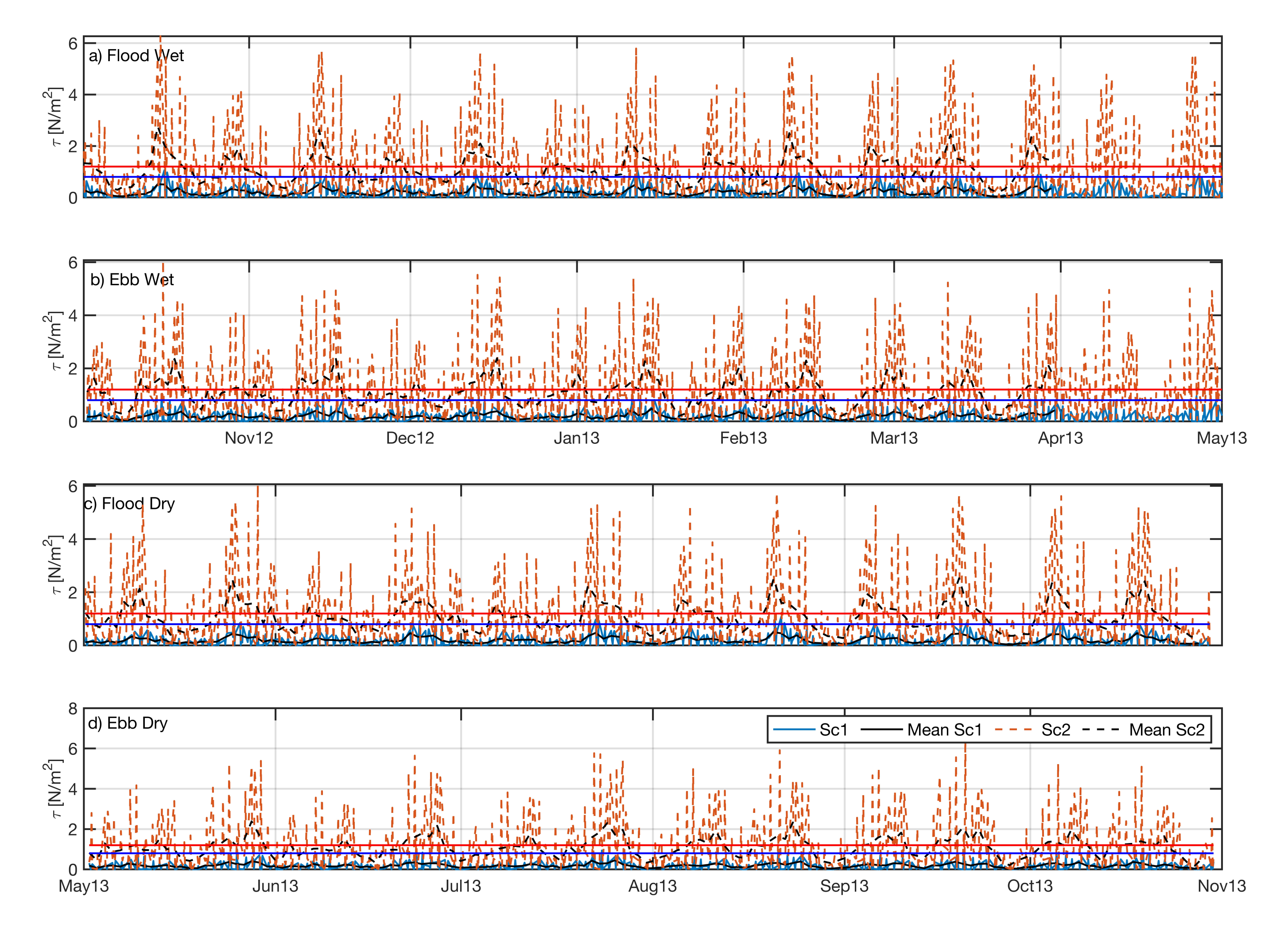
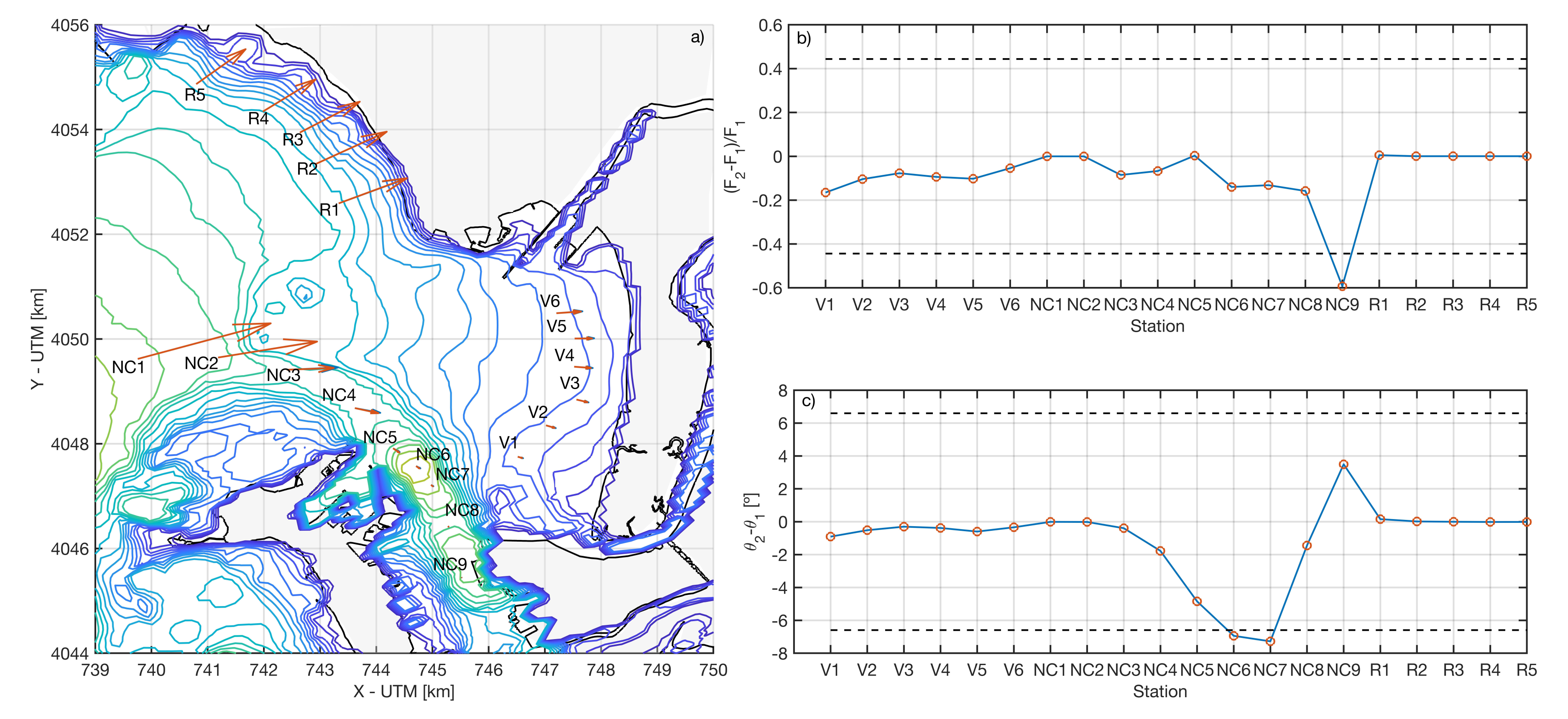
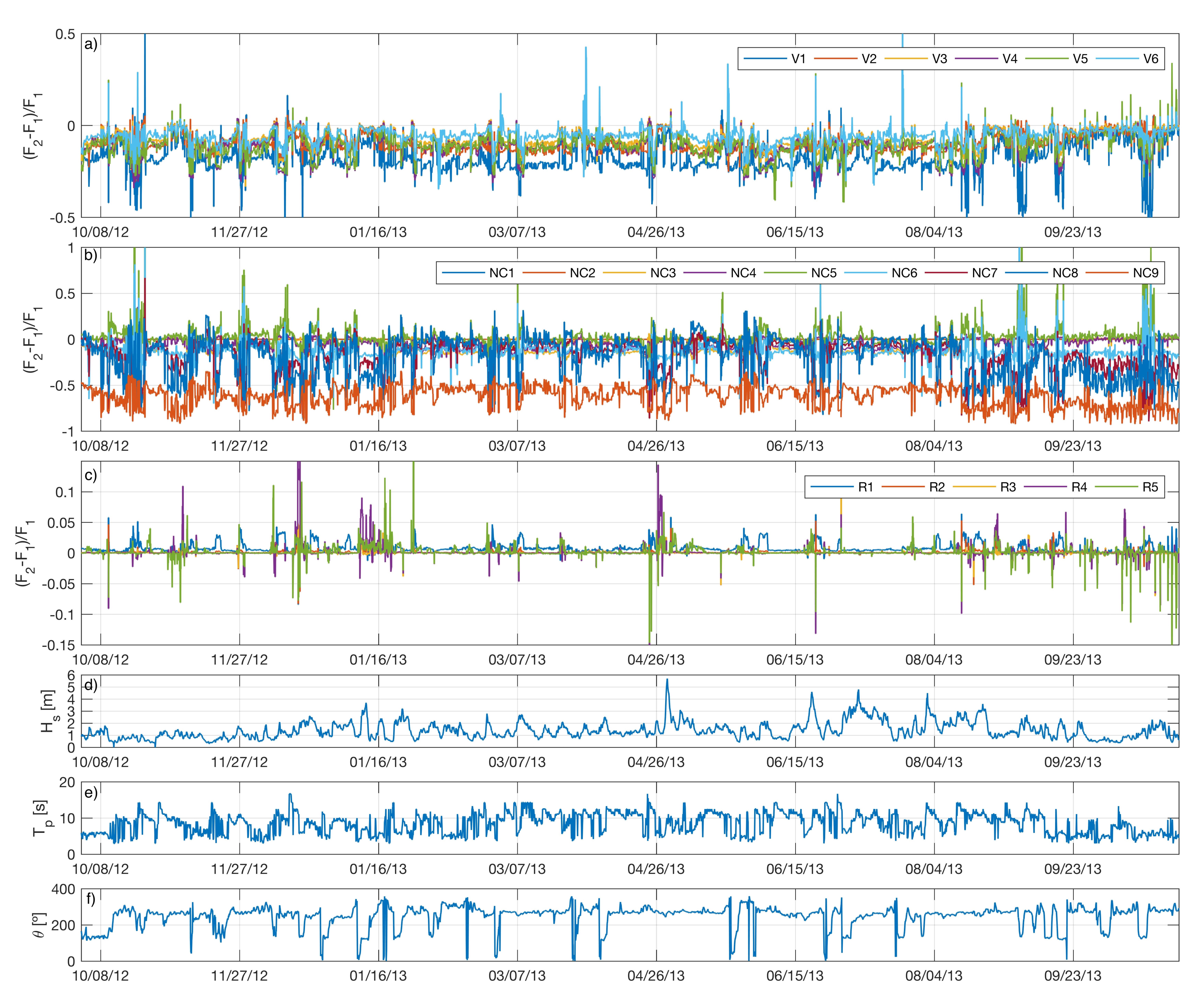
| Parameter | Data |
|---|---|
| 4.94 × 10 m | |
| 9.8 × 10 | |
| 10 m | |
| 0.017 m | |
| 10 m | |
| L | 10000 m |
| V | 8.19 × 10 m |
| 1.19 × 10 m | |
| 1.43 × 10 m |
© 2020 by the authors. Licensee MDPI, Basel, Switzerland. This article is an open access article distributed under the terms and conditions of the Creative Commons Attribution (CC BY) license (http://creativecommons.org/licenses/by/4.0/).
Share and Cite
Zarzuelo, C.; López-Ruiz, A.; Ortega-Sánchez, M. Beyond Human Interventions on Complex Bays: Effects on Water and Wave Dynamics (Study Case Cádiz Bay, Spain). Water 2020, 12, 1907. https://doi.org/10.3390/w12071907
Zarzuelo C, López-Ruiz A, Ortega-Sánchez M. Beyond Human Interventions on Complex Bays: Effects on Water and Wave Dynamics (Study Case Cádiz Bay, Spain). Water. 2020; 12(7):1907. https://doi.org/10.3390/w12071907
Chicago/Turabian StyleZarzuelo, Carmen, Alejandro López-Ruiz, and Miguel Ortega-Sánchez. 2020. "Beyond Human Interventions on Complex Bays: Effects on Water and Wave Dynamics (Study Case Cádiz Bay, Spain)" Water 12, no. 7: 1907. https://doi.org/10.3390/w12071907
APA StyleZarzuelo, C., López-Ruiz, A., & Ortega-Sánchez, M. (2020). Beyond Human Interventions on Complex Bays: Effects on Water and Wave Dynamics (Study Case Cádiz Bay, Spain). Water, 12(7), 1907. https://doi.org/10.3390/w12071907







